|
Ernabella
Arts
Ernabella Arts is believed to be the longest continually
run Aboriginal art centre in Australia, celebrating
its 50th Anniversary in 1998.
Mission
statement
Anapala Arts ngura nyangangka Anangu kami tjutangku,
ngunytju tjutangku untalpa tjutangku kulu walkatjura
palyalkatipai tjanampa culture pulkantjikitjagju Anangu
Anapalanyangurara tjuta palya mulapa nyinantjaku.
Ernabella
Arts is a place where Pitjantjatjara grandmothers,
mothers and daughters practice and develop their art
in order to sustain, support and promote their cultural
heritage and improve the lifestyle of local community
members.
Ernabella Arts Incorporated is an Aboriginal Incorporated
Association, located on the Anangu Pitjantjatjara
Land (freehold) in the north-west of South Australia.
Ernabella is a community of about 400 Pitjantjatjara
people, living a relatively traditional lifestyle
in the small town and surrounding homelands. It began
in 1948, and was incorporated in 1974, firstly as
Ernabella and Fregon Arts Inc. and then changing to
Ernabella Arts Incorporated in 1975.
The
centre acts as a community based artists' association
through which artists can sell individual artworks
or work on a daily basis. The members and chairperson
of the Association are drawn from local practising
Pitjantjatjara artists and they employ a co-ordinator
to assist in enterprise development. Wages are paid
through the Community Development Programme (CDEP)
and artists can choose to work in many media.
The
underlying design basis comes from the fluid, curvilinear
abstract forms derived from the traditional women's
practices of Milpatjunanyi (sand-story) and
the decorations painted on the body for inma
(ceremony). The women consistently refuse to attach
specific meanings to these designs, known here as
Ernabllaku Walka which occur across the Pitjantjatjara
lands, but they do acknowledge that they are indirectly
inspired by their natural environment.
(Ernabella Arts Inc)
Weaving
at Ernabella
Weaving was introduced at Ernabella in the late 1940s
to provide employment for the women.
In
the summer of 1948-49 Mrs Bennett… brought a
small table-loom. In 4-6 weeks she taught four older
women to adapt their spinning technique which was
to roll the fibre against the leg, used for the spinning
of human hair, to the spinning of wool on the property.
Four younger women were taught weaving. The older
women collected wool and took it away to their more
familiar camp, and the others made floor-rugs in a
craft room. Rug weaving gave the Pitjantjatjara women
a means of using their beautiful abstract designs.
(Hilliard in Cochrane, 1992: 139)
Batik
at Ernabella
By the 1970s the people of Ernabella
Arts were successful rug weavers and later batik
artists. More recently they have become involved in
screen-printing.
Leo
Brereton, a New York artist, conducted a batik workshop
at Ernabella in 1971.
Brereton
was appointed to Ernabella for two months, and batik
proved popular, not only because it was quicker and
more directly satisfying than weaving, but also because
it proved to be particularly appropriate for the forms
of traditional design. Danish artist, Vivianne Bertelsten
also went there in 1975-76, introducing napthol and
permanent indigosol dyes and a range of waxes…
(Cochrane, 1992: 243)
In
1975, three artists, Nyukana Baker, Yipati Kuyata and
Jillian Davey attended the Batik Research Institute
in Jogjakarta, Indonesia to develop their skills. Ernabella
Arts Incorporated is now renowned for their batik, in
particular the four metre silk lengths produced by the
artists.
As
the artists became more skilled, and the popularity
of batik in other communities increased the artists
demonstrated their techniques.

Textile
length, Puti (bush), cotton, screen-printed.
Designed by Nyukana Baker and Nyuwara Tapaya 1989/90.
Printed by Marie Warren, 1995. 95/319/3. Powerhouse
Museum Collection. |

Photo:
Nyukana and Nyuwara, by Jenni Dudley, 1995. Courtesy:
Ernabella Arts. |
Screen-printing
was introduced in the early 1990s. Ernabella's artists
were commissioned in 1993 to produce furnishing fabrics
for clients including:
- Uluru
National Park offices
- Community
Aid Abroad
- The
Underground Motel, Coober Pedy.
More
than 2 500 metres of screen-printed fabric was produced.

Textile length, Nguratjara
(Visions of Home), cotton, screen-printed, designed
by about 13 Ernabella artists 1989-1990, printed
by Marie Warren in 1995, Ernabella, South Australia.
95/319/1. Powerhouse Museum Collection.
|
Tiwi
Design
Melville and Bathurst Islands are located 80 km north
of Darwin across the Dundas Straits. The people living
on these islands are the Tiwi people.
The
Tiwi people have had contact with visitors since the
Macassans (15th and 16th centuries). They have also
had contact with Malaysian, Indonesian and Japanese
pearlers. Fort Dundas, now Nguiu, was established by
the English in 1824 and a Catholic mission was established
on Bathurst Island in 1911.
Tiwi
art, culture and language are very different to mainland
Aboriginal groups. There was traditionally little contact
between these two groups. Body adornment and burial
poles were the traditional Tiwi art forms. The style
was abstract and this can be seen in the work of textile
artists, painters and sculptors.
In
the 1960s Tiwi artists
…began
to produce woodblock prints of totemic images,
having learnt the basic techniques at school…
Other forms of printing were tried and in 1969 Tiwi
Designs was established at Nguiu to produce screen-printed
fabrics… The early designs, …were inspired
by the environment around them and incorporated fish,
bird and lizard motifs. As the designers themselves
grew more assured, artists began to draw their inspiration
from traditional patterns used in body painting, pukamani
poles and bark painting. (Rowley, 1997: 55)
Tiwi
Designs is now known as Tiwi Design. The Snake (Taringa)
design by Bede Tungutalum (Tiwi Design) has been used
in Lenore Dembski's
Snake shirt and shorts set.

Textile length, Jurrukuni
(Owl), black screen-print on rust-red cotton, designed
as a border pattern by Giovanni Tipungwuti in 1973,
re-developed as an all-over design by Osmond Kantilla
1993. Printed at Tiwi Design, Bathurst Island, Northern
Territory in 1996. 96/303/1. Powerhouse Museum Collection.
|
Arts centres
A number of arts centres have been established on these
islands including Jilamara
Arts and Crafts Association, a cooperative established
in 1986 on Melville Island. Begun as a six-month women's
screen-printing program, the organisation was incorporated
in 1989. James Bennett, the arts coordinator introduced
fibre reactive dyes screen-printed onto silk lengths
and scarves.
The
centre currently produces screen-printed silk lengths
using fibre-reactive dyes, and cotton lengths printed
with inks… The association is also starting to
license some of its designs to manufacturers and designers
within the fashion industry. (Green in Desart, 2000:
84)
Bima
Wear
Bima Wear was originally established in 1969, by Sister
Eucharia of the Catholic Church Mission on Bathurst
Island. The purpose was to make clothing for the locals.
In 1975, Bima Wear moved to a larger building and began
using the printed textiles made by the men in Tiwi Design.
By 1976 fourteen women were producing 300 garments each
week. Bima Wear was incorporated in 1978 and over the
years has increased its turnover to 17 000 garments
per year. Most of the garments were sold in the Top
End of Australia. In 1982 screen-printing was introduced
and garments were sold direct from the factory showroom.
By
the end of the 1980s Bima Wear was a successful business.
In 1990 they exhibited hand-painted silks and prints
on paper at the Powerhouse Museum, Sydney. Their work
also travelled from 1989-90 in the touring exhibition
Australian Fashion: The Contemporary Art of Dress.
(Desart, 2000: 84)
The
fabrics produced at Bima Wear feature the:
…ancient
symbols, structures, family and environmental representations
which are central to their culture…
The
two main artists-screen-printers are Fiona Kerinauia
and Theresa Munkanome. They supervise the other women
and trainees in artwork, manufacturing of screens
and printing.
In
1987 Bima Wear designed and printed the vestments
worn by Pope John Paul during his visit to the Northern
Territory. (Bima Wear)
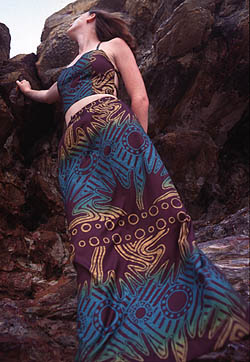
Brown hands, para silk (100%
synthetic)
Textile artist: Fiona Kerinauia: Bima Wear (Bathurst
Island NT)
Method: hand screen-printed, 1 metre screens
Model: Leanne Mohony
Photographer: Edwina Flershannon
Courtesy: Lenore Dembski |
Utopia
A cattle station from 1927, the Utopia
homelands in north eastern Central Australia were returned
to their traditional Anmatyerr and Alyawarr owners in
1976. The artists live in camps near ceremonial sites
on their clan lands.
Like
the artists at Ernabella the women artists at Utopia
were introduced to batik in the 1970s. Utopia Awely
Batik Aboriginal Corporation operated as an artists'
cooperative. Their body painting with ochres for the
awely, women's ceremonies, are the artistic basis for
their designs in batik. As with Ernabella some of the
artists visited the Batik Research Institute in Jogjakarta,
and had a close connection with Brahma Tirta Sari
Studio, a private batik studio there, in the 1990s.
|
Each
Utopia artist develops designs based on their
personal animal or plant totem. Mostly a tjanting
or canting (a tool used to apply wax to
fabric, featuring a copper well with a nib and
a handle) and brushes are used. However at times
a cap is used, a hand-held copper stamp. The women
however prefer to sit and not stand at a table,
so the tjanting and brushes are preferred.
Batik
and acrylic painting, developed from traditional
body and ground paintings, have become important
new forms of cultural expression, alongside traditional
practices. Art for an external market is also
a central part of the local economy and until
2000 was coordinated through the Utopia Awely
Batik Aboriginal Association and now the Utopia
Cultural Centre.
|
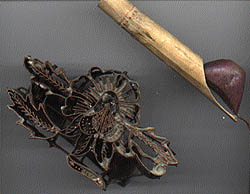
Cap and tjanting. Courtesy: Julie
King. |

Textile
length, silk batik, made by Glory Ngale (from Utopia,
Northern Territory), at the Powerhouse Museum, Sydney,
1997. Description: white silk satin, azoic dyes
in purple and blue, with bold brush and tjanting
designs including Glory's honey grevillea motif
(a flower shape with stamens), centipedes, echidnas,
lady beetles, lizards, bush raisin, bush yam, bush
tobacco (pituri), head lice and grasses.
98/4/1. Powerhouse Museum Collection.
|
Designed and made by Glory Ngale (Anmatyerr language
group) at the Powerhouse Museum in September 1997 as
part of a public program during the exhibition of Hot
Wax, an exhibition of batiks made by artists from
Utopia in Indonesia in 1994. Wax was applied using a
tjanting and brush process, with several applications
of dye. Designs are based on personal totems of ancestral
plants and animals from the Altyerr, the Dreaming,
and patterns from body paintings used during their awely,
or women's ceremonies.

Gladdy and Nora Kemarre and Glory
Ngale from Utopia in Central Australia make batik
at the Powerhouse Museum as part of the 1997 Festival
of the Dreaming. Photo: Grace Cochrane.
|
Activity
1. Discuss the cross-cultural use of textile production
techniques.
2. Identify the advantages of study tours in another
country.
Keringke
Arts
Located 80 km east of Alice Springs at Santa Teresa
or Ltyentye Apurtethe (population 500 Eastern Arrernte
people), Keringke Arts was set up as a result of a fabric
painting course conducted for twelve women in 1987 by
Cait Wait. Keringke Arts specialises in hand-painted
silks and clothing.
The
majority of Keringke artworks are not accompanied
by specific stories, yet artists do draw on a strong
traditional narrative for inspiration, structured
around age-old motifs, landscape forms, the elements,
daily life, food gathering, and the flora and fauna
of the local countryside. To the present day, all
artists at Keringke Arts have been women.
(Desart, 2000: 83)
Their
work was first exhibited in 1988 at the Bicentennial
Australian Craft Show (Sydney) and again in 1989. They
have continued to exhibit including both solo and group
exhibitions.
Desert
Designs: Jimmy Pike
Desert Designs is a commercial business which originated
in Western Australia in the 1980s. Many of their designs
are created by an Aboriginal man, Jimmy Pike, from the
Kimberley region. His traditional land is the Walmajarri
Great Sandy Desert country. Desert Designs now sells
products internationally.
Jimmy
Pike's prints and painting… added a new dynamism
to the continuing central position of landscape in
Australian art. Simultaneously they project a new
dimension to connections of place and identity. The
artist's work, with its themes of the intimate intricacies
of his desert's landscape, the visual character of
the changing seasons and the particularities of its
Aboriginal spirituality, has transformed this almost
invisible and extremely isolated area of the northern
part of the continent into a tangible experience and
a rare encounter with both its beauty and sacredness.
(O'Ferrall, 1995: 7)
Jila,
water holes and jilji, rolling sand dunes, are
important motifs in Pike's work and are central to the
patterning found in Walmajarri art work, for example,
body painting.
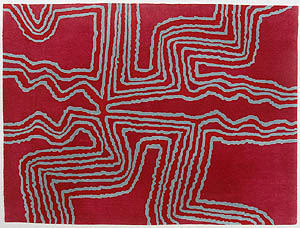
Jilji and Kurrminti
rug designed by Jimmy Pike, manufactured in Thailand
for Desert Designs 1987. Gift of Gloria and
Arthur Bishop 2000. 00/54/1.
Powerhouse Museum Collection. |
Jimmy
Pike began his life as an artist in Fremantle Prison
where he attended art classes taught by Steve Culley,
a founder, with David Wroth, of Desert Designs. Pike
first worked with texta colour and then acrylic paint
and oil pastel. Pike also made black-and-white lino
prints which were later made into screen-prints.
The
transposition of Pike's work onto textiles first occurred
in 1985. Aboriginal textiles with contemporary designs
had been pioneered in the 1970s on Bathurst Island
by Tiwi Bima Wear and at Ernabella and Utopia with
the production of batik textile lengths. The earliest
Pike designs selected for transfer onto cotton were
chosen for their combination of strong linear character
and colour range.
The
intention in developing the first line of textiles
was to jump over the stereotypical "craft-based"
association of individual design and textiles. Instead,
Culley and Wroth wanted to generate a product that
would fully interface with the professional commercial
world of contemporary design and fashion without losing
the essence of Jimmy Pike's creativity and its Aboriginal
cultural integrity. They used local fashion designer
Lon Riley and seamstress Nina Boydelle to prepare
suitable patterns for their first small range of fashion
garments which they sold through individual boutiques
around Perth. (O'Ferrall, 1995: 12)
Desert
Designs
…were
introduced to the commercial design licensing process
and J.H. Byers' fashion company. After seeing their
concept storyboards and Fremantle-produced clothing,
Byers expressed interest in licensing specific designs
for a range of children's wear and women's fashion,
with the first release occurring in the summer of
1986/87. (O'Ferrall, 1995:12)
Licensing
agreements were also established with Oroton and Sheridan
allowing Desert Designs access to a national market.
Jimmy
Pike was released from prison in 1986. Culley and Wroth
discussed with him strategies to allow him to work full-time
as a painter.
In
1987 a Jimmy Pike: Desert Designs exhibition
was held in the Seibu store in Japan. The exhibition
travelled around Japan for six months. A second tour
was organised in 1989 and designs were licensed for
a range of ski wear and beach wear. Desert Designs opened
stores in the mid- to late- 1980s in Sydney, Surfers
Paradise and Fremantle.
In
1988 women's clothing produced by J. H. Byers' company
won the New Talent category of the Bicentennial Fashion
Awards. 1989 saw the opening of a European office and
new marketing directions. Further licenses were negotiated
in 1991 and 1992. A Desert Designs gallery shop was
opened in France (1991-93).
Activity
Draw a timeline to show the development of Desert Designs.
Bronwyn
Bancroft
Bronwyn Bancroft is one of the most successful Aboriginal
artists and designers. Her work includes artwork and
textiles for fashion and furnishings. Bronwyn Bancroft
is from the Banjulung nation of northern NSW and was
born in Tenterfield in 1958. Her art training took place
at the Canberra School of Arts. Her work reflects a
contemporary perspective on the family, politics and
the natural environment.
In
Aboriginal tradition, the Rainbow Serpent is the creator.
Meanderland shows the serpent surging through
the land, creating and nurturing the elements of life.
Aboriginal people have a strong link with the land
because they are responsible for it. (Bancroft)

Meanderland
textile by Bronwyn Bancroft
Screen-printed cotton fabric, 1993. 94/19/1.
Powerhouse Museum Collection. |

Serpent dress designed by Bronwyn
Bancroft. Modelled by Anthea Carter.
Hand-painted Lycra, 1987. 94/120/5
Photo: Anthea Carter.
Powerhouse Museum Collection. |
Designer
Aboriginals
Bronwyn ran a successful company, Designer Aboriginals,
in Rozelle, Sydney, from 1985 to 1990, where she sold
printed and hand-painted fabrics, clothing and jewellery.
Recognition
of her talents in the high-fashion arena came when
she and four other Koori designers were invited to
parade their garments at the prestigious department
store Au Printemps in Paris in 1987.
Her
original designs have also featured in the Powerhouse
Museum's exhibition The Contemporary Art of Dress,
which travelled to the Victoria and Albert Museum
in London in 1988. (Cochrane Simons, 1991)
The
opera cape below was paraded at the Paris department
store Printemps in the Fashion Extravaganza organised
by the Aboriginal Medical Service in 1987. The figures
on the front and the lizard on the back, represent the
journey through life of an Aboriginal man and woman.
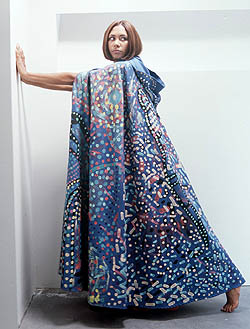
Cycle of life opera cape
designed by Bronwyn Bancroft. Modelled by Anthea
Carter.
Cotton drill, handpainted, 1987. 94/120/2. Powerhouse
Museum Collection. Photo: Bronwyn Bancroft. Photo:
courtesy IBM. |
|
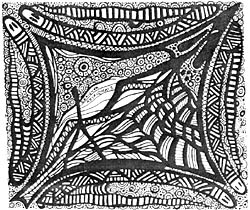
Snake escape
Snake escape is based on the concept, some might
say the illusion, of freedom. The snakes are escaping
along their own paths but are always, paradoxically,
moving in a circle, to end up where they began.
The
design is also a positive affirmation of life,
celebrating in its circular forms, the ongoing
quality of all the elements of existence. Courtesy:
Bronwyn Bancroft.
|
|

Snake escape
The snake escape motif is printed in a repeat
pattern. Courtesy: Bronwyn Bancroft.
|
Community involvement
Bronwyn has always been actively involved with her community.
She chaired the National Indigenous Arts Advocacy Association
(NIAAA) for three years and has consulted on and organised
many projects.
|
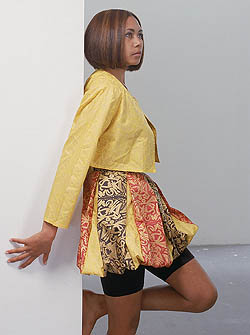
Land rights
outfit designed by Bronwyn Bancroft. Modelled
by Anthea Carter.
Made from screen-printed polyester taffeta, 1987.
94/120/. Powerhouse Museum Collection.
|
This
outfit is a powerful statement of Aboriginal identity
featuring the colours of the Aboriginal flag and an
Aboriginal paisley print. Bronwyn developed this
print as a satirical comment on the long history of
the European paisley, itself drawn from the Indian boteh
design.
Bronwyn
as artist
Bronwyn is a prolific artist, initially designing textiles
and fashion. More recently she has had great success
with painting, graphic design commissions and exhibitions
in many countries.
In
1991 she was granted a fellowship by the Aboriginal
Arts Board of the Australia Council. Major artworks
have been purchased by the Australian National Gallery
and other public and private collections.
She
has exhibited in two-person shows with Sally Morgan
and with Jimmy Pike, and had a successful solo exhibition
in Canberra earlier this year. (Cochrane Simons, 1991)
Her
Sydney exhibition, The great Australian amnesia,
conveyed a powerful message that Aboriginal culture
is alive and well.
In
1995 Bronwyn Bancroft painted Jeans for Genes Day
jeans for Cathy Freeman to autograph.
I
am painting Cathy Freeman's jeans to indicate the
essence of strength and power that Cathy encapsulates.
The imagery is of snakes and lizards moving really
quickly across the Australian terrain. Just as Cathy
does, not only in Australia but on the world stage.
I have also painted a rainbow background to show the
optimism that Cathy emanates for all the Aboriginal
people. (Bancroft, 1995: 30)
Journey
of a nation
Bronwyn was also the designer for the opening of the
Journey of a nation Federation parade in Sydney
in January 2001. The section acknowledged the Aboriginal
and Torres Strait Islander population and the language
groups of the NSW region.
|
Tobwabba
Art
Tobwabba
Art is 100% Aboriginal community owned.
|
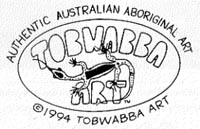
Courtesy:
Tobwabba Art |
The
urban coastal Aboriginal art and design is the subject
of an extensive commercial licensing program aimed
at the tourist, souvenir and general giftware markets
in Australia and overseas.
Tobwabba
Art tells the story of the Worimi people from the
Great Lakes region of New South Wales. Before contact
with white settlers nearly 200 years ago, the Worimi
extended from Port Stephens in the south to Forster-Tuncurry
in the north and as far west as Gloucester.
Tobwabba
means a place of clay and refers to a hill
near Forster, on which the descendants now have their
homes at a mission called Cabarita. Tobwabba
Art is a business enterprise developed for, and with,
the artists, by their own local land council.
The
people now number less than 200, and from these families,
in the main, come the 20 Tobwabba artists. In their
work, they express their own life and what they imagine
the life of their ancestors to have been.
Artwork
is specially developed by the artists for each licensed
product. Product packaging, labels and swing tags
prominently display Authentic Australian Art.
Royalties
from the sale of all licensed products go to the artists
and benefit the Worimi community.
(Tobwabba Art Product Catalogue)
The Worimi is made up of several clans: The Buraigal,
the Gamipingal and the Garawerrigal.
The
people of the Wallis Lake area, called Wallamba,
had one central camp site which was the place now
known as Coomba Park. Their descendants, still living
today, used this camp site till 1843.
The
Wallamba had possibly up to 500 members before
white contact was made. The middens around the Wallis
Lake area suggest they had ample food and ate whelk,
pipi, oyster, crab, cockles, venus shell and prawns
as well as many varieties of fish, yams and occasionally
wallabies, kangaroos, echidnas, waterfowl and fruit
bats.
Fire
was an important feature of their life, both for their
campsites and the periodic 'burning' of the land.
(Tobwabba Art Product Catalogue)
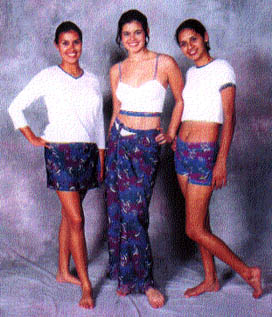
Photo: Geoff Tull. Courtesy: Tobwabba
Art |
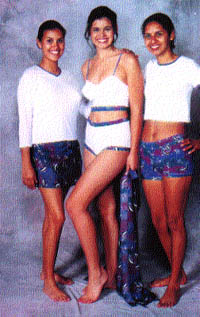 |
|
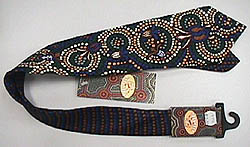
Courtesy: Tobwabba Art
|
|
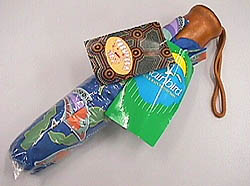
Courtesy: Tobwabba Art
|
Activity
Take
a tour of Tobwabba Art www.tobwabba.com.au
To start visit:
Sorbie Collections
Lisa Sorbie Martin is of Torres Strait Islander heritage
from the mid western island called Moa and the island
of Mer known as Murray Island. Lisa was named
after her grandmother Mary Sorbie Ware of Murray Island
(Mer). Sorbie is a traditional Mer name meaning wild
water cherry.
She
has been designing textiles since 1998. Her work is
a mixture of silk batik and hand-painted textiles and
more recently she has been designing evening gowns and
casual street wear. The designs of her work are influenced
by her Torres Strait Islander heritage, beginning with
the design on the textile through to the design of the
garment. The entire outfit tells a story of the Torres
Strait.
The
impressionistic wedding dresses were featured in fashion
parades called Fashion the Indigenous Way, which
highlighted Indigenous fashion designers, textile artists
and models in the lead up to the opening of the Sydney
2000 Olympic Games at the Sydney Media Centre and the
Powerhouse Museum.
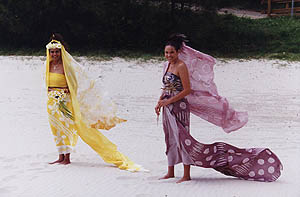
Lisa and daughter with impressionistic
wedding dresses. Courtesy: Lisa Sorbie Martin: Sorbie
Collections. |
Sorbie
has exhibited her work extensively throughout Australia
and recently won the Indigenous category at the Taree
Flair Fashion Awards in July 2001. She was also one of
ten designers selected as finalists representing Queensland
in the Mercedes Benz Fashion Start Up program in October
2001.
She
states:
The
art that I produce is a reflection of myself. This
expression has many attributes stemming from my lifestyle,
ideas, experiences, passions, beliefs, environment,
my culture and my heritage.
As a Torres Strait Islander artist these attributes
flow throughout my artwork, showing a reflection of
my culture with all its richness and culture.
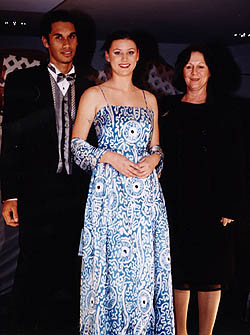
Evening dress: The design represents
silver bream fish. The blue background represents
water and the sequins represent the scales of the
fish. At the back is flowing blue chiffon with sequins
at the bottom, again representing the flowing water
and fish scales. Courtesy: Lisa Sorbie Martin: Sorbie
Collections. |
Activity
Draw a chart like the one below to compare and contrast
five of the Aboriginal and Torres Strait Islander designers
outlined.
| Designer |
Sources
of inspiration |
Traditional
influences |
Contemporary
influences |
| |
|
|
|
Summarise
the similarities and differences between these designers.
For
more information on contemporary Aboriginal and Torres
Strait Islander textiles:
Desart (2000) Putting in the colour, Contemporary
Aboriginal textiles, Jukurpa Books, Alice Springs,
iadpress@ozemail.com.au
or PO Box 2531 ALICE SPRINGS NT 0871.
|